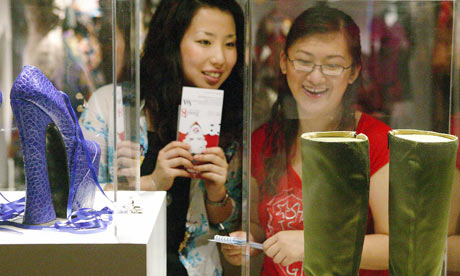Vivienne Westwood and Burberry open more boutiques to meet demand for luxury clothes For decades western fashion brands have looked to China for cheap materials and labour. But in recent months the country has caught the attention of the fashion industry for a different reason: thanks to its booming economy, numerous high-profile fashion houses have announced their intention to expand operations on the Chinese mainland. Vivienne Westwood is to open 20 boutiques in China, and fellow British fashion house Burberry has confirmed that it will add 66 stores to its current 44 Chinese outlets by 2012. The American leather goods company Coach is to open 20 outlets in China this year and the Italian handbag and luxury clothing producer Ferragamo plans 10 stores. James Dorn, a China analyst for the Cato Institute, said: "When I first visited China in 1988, most people in Shanghai were still riding bicycles and wearing poorly made clothing. There were only a few luxury hotels. Today, Shanghai is a vanguard city, and the rich and growing middle class demands top-quality fashion, homes and cars." Last month, celebrities including Marion Cotillard and Charlize Theron joined John Galliano, the creative director of Christian Dior, for the French fashion house's debut show in Shanghai. "It's a very fast evolution not only in terms of consumption but also in the level of sophistication," says Dior president Sidney Toledano. "They [Chinese consumers] like to buy something iconic, which has meaning in terms of quality and is something unique." Last year, luxury fashion houses such as conglomerate LVMH saw a distinct boost in sales to the Chinese market. It is estimated that the Chinese bought $7.5bn worth of luxury products last year. "We estimate retail sales will grow 16-18% this year," says Jessica Lo, of the China Market Research Group. A report published by McKinsey last autumn predicts that consumption will double in China's 100 biggest cities between 2008 and 2015. "China can no longer be seen as just a low-cost production centre. Consumers are getting wealthier and shopping more, they remain optimistic about the economy and their own job prospects," Lo said. "Eighty per cent of women told us they would spend more in the next six months than they did in the last six months. Consumers in less famous cities like Chongqing are spending a lot, too." Toledano echoes this observation: "It's rather consistent. Obviously Shanghai has more clients today, but a city like Guangzhou has fantastic potential. It's amazing. You can see so many cities with potential for luxury. Even in Europe... if you take England, for example, frankly outside of London it's much more difficult [than in China] to find shoppers interested in luxury goods. It's the first time we have seen so many cities with big potential." Tom Ford, the former creative director of Gucci, is rumoured to be eyeing sizable retail spaces in Shanghai. And, fellow Los Angeles-based shoemaker George Esquivel plans to open his first stand-alone store in Beijing later this year. Lo warns that western brands should not bank on Chinese consumers directly paralleling European and American shoppers when it comes to taste and aesthetic appetites. "Many western companies forget to localise both their styles as well as advertising. They use celebrities and images that work in the UK and Europe, but that don't resonate with Chinese consumers. It is critical that companies get the right product selection and style and advertising image." Levi's has announced that it will debut a new brand this summer exclusively for China. The company is also planning to expand its number of stores in China from 20 to 1,000 by 2015. Dior has also introduced items made exclusively for the Chinese market. Called the Blue collection and consisting of 12 different pieces, the line is currently on sale only at Dior's revamped Shanghai shop. "I wouldn't say there's one theme; China is a heavily fragmented country with a heavily fragmented consumer base," says Cody Ross, who has been selling his avant-garde brand Priestess in China for the past three seasons. "In terms of design and silhouette I have certainly tailored to local taste. For instance, I did a Qipao dress: it's a traditional Ching dynasty dress, demure and conservative. A lot of designers have adapted looks because the Chinese are obsessed with history and dynasty, and that's always sort of the Zeitgeist."Leading British fashion brands entice China's nouveau riche

Subscribe to:
Post Comments (Atom)





0 comments:
Post a Comment